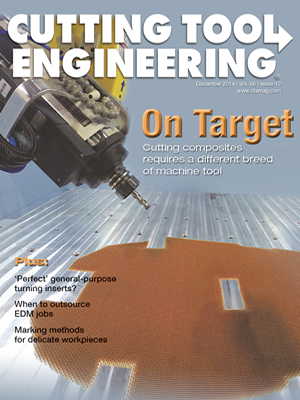Although pricey, composite materials are strong, heat-resistant and lightweight and, therefore, continue to make inroads into a host of industries. Composite parts enable aircraft, for example, to reduce fuel consumption, improve combustor efficiency and power jet engines at a higher thrust. As a result, more composite parts will be machined for aircraft and other applications.
An array of materials fall under the composites umbrella, including fiberglass, ceramic matrix, carbon fiber reinforced and silicon carbide. Each type has unique characteristics, and differences exist even within the same type.
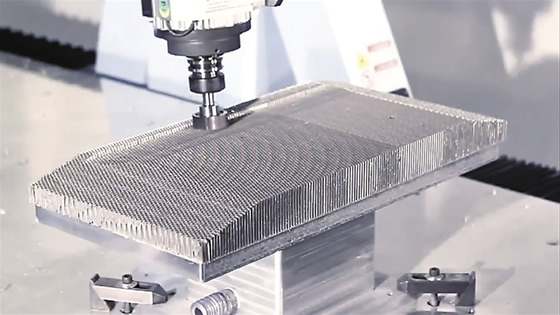
Courtesy of Diversified Machine Systems
Diversified Machine Systems cuts a honeycomb composite material on an enclosed 5-axis, large-format, overhead-gantry CNC router with continuous C-axis rotation.
“The number one thing in composite machining, which a lot of people don’t understand, is every program and every composite is different,” said Evan Kooda, senior manufacturing engineer for Janicki Industries Inc. “Every program has a different type of composite, and each requires different types of cutting tools.”
The Sedro-Woolley, Wash., company does lay up of composite parts, machines composites and builds machining centers for internal use. “Nobody else gets access to the technology we’ve developed in-house,” Kooda said.
The technology includes contra torque gear motors to eliminate backlash and allow a change in direction while machining without producing any slop in the machine, and linear motors on the X, Y and Z axes—similar to a maglev train. “There is no gearing in that system,” he added about the linear motors. “It’s just a motor against a magnet.”
Cutting Composites
Although cutting tools and machining techniques can vary for each composite workpiece, if a parts manufacturer has a top-of-the-line machine tool for the worst-case composite-machining scenarios, the machine can cut the full spectrum, according to Patrick Bollar, CEO of Diversified Machine Systems, Colorado Springs, Colo. The company builds machining centers for a wide customer base, with about 60 percent of the machines being one-offs that are shipped in 14 to 16 weeks, on average.
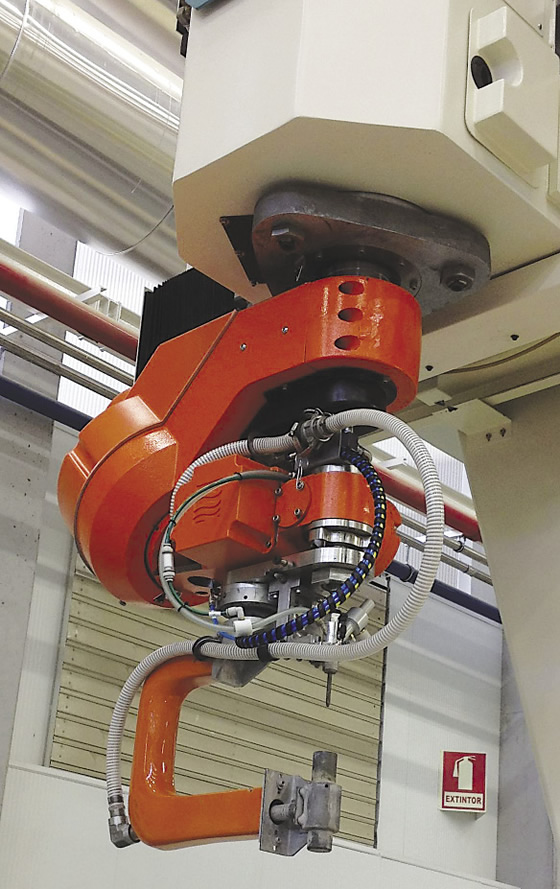
Courtesy of Flow Aerospace
In addition to a head for milling, drilling and routing, Flow Aerospace's Composite Machining Center has a 5-axis waterjet head with an arm that functions as a 6th axis and holds a cup to catch the water, abrasive and material from the part.
He noted the DMS 3- and 5-axis machining centers provide a universal platform for machining aluminum, all forms of honeycomb material, composites, plastics, wood and foam.
A decade or so ago, Randy Von Moll, technical sales director for Fives Cincinnati, Hebron, Ky., said light-duty, accurate woodworking machines were frequently employed to produce composite aerospace parts that were not necessarily critical for safety, such as fairings and cover panels. However, with the current need to machine primary load-carrying airframe structures, those machines won’t cut it.
Airplane builders are becoming more like automakers, requiring that parts be manufactured to tighter tolerances so they bolt together without fitting operations during assembly. “This requires much more accurate and much more repeatable machine tools,” Von Moll said. “You need a machine that is very stiff.”
He added that the machine tool builder offers the Cincinnati Precision Mill and Trim (PMT) for machining cured composites, as well as nonferrous alloys. According to the company, the PMT performs 5-axis, five-sided maneuvering, is built on a rail-type, vertical-spindle gantry platform comprised of standard modules and offers an unlimited X-axis range and a traverse speed up to 60 m/min. (2,362 ipm).
Flow Aerospace LLC also offers a gantry-type machine for cutting composites, but with a twist. Chief Engineer Mark Saberton explained that its Composite Machining Center has two vertical masts on the gantry: One mast has a 5-axis drilling and routing head and the other has a 5-axis waterjet head with an arm that functions as a 6th axis and holds a cup to catch the water, abrasive and material from the part.
The captured material is evacuated through the machine and into a system that separates the water, which goes down the drain, from the solids, which are nonhazardous and deposited in a 55-gal. drum for disposal. The Jeffersonville, Ind., machine builder is part of the Ascent Integration & Automation Group of Ascent Aerospace, a wholly owned unit of AIP Aerospace, Santa Ana, Calif.
Down with Dust
Machining composites tends to generate a different type of chip than the metallic variety, one that resembles dust. Some people call them chips but they’re really tiny particles comprised of carbon and epoxy, Saberton said, adding that grain size varies along with the workpiece.
On the other hand, Tom Cornwell, sales and application specialist for LMT Onsrud LP, described the composite chips as microscopic “sixes” and “nines,” even if they appear to be a fine powder. The Waukegan, Ill., company makes cutting tools for machining advanced materials, such as the 66-700 series of diamond film-coated, low-helix tools for tackling abrasive composites.
“They will look like chips if everything is done right,” Cornwell said, noting that’s the case for the fibrous material and the resin, which holds the structure together. “It won’t be dust, it’ll be chips, and you can carry the heat away with the chips. That keeps the tool and the part cooler. The benefits are increased tool life and protection against the risk of part delamination.”
He added that the machining process is more like grinding than cutting, because of the smaller size of the chips.

Courtesy of LMT Onsrud
LMT Onsrud offers cutting tools for machining carbon fiber-reinforced composites, such as the 66-700 series, with a low-helix flute angle to reduce vibration. According to the company, the open flute geometry dissipates heat to prevent resin flow.
Saberton concurred that the process is similar to grinding, where the tool fractures the workpiece, compared to the shearing action seen when machining metal. “Everybody tries to draw an analogy between machining metals and machining composites and there’s no correlation between the two whatsoever,” he emphasized. “If you try to shear a composite, you rip it to pieces.”
Nonetheless, metal can be found in composite structures, such as in sandwich-structured composites and other arrangements. “In a lot of cases, the outer skin of these aircraft will include some copper lightning-strike material, which also has to be machined as part of the process,” Cincinnati’s Von Moll said.
Whatever it’s called—microscopic chips, grains or dust—the material removed from the workpiece must be controlled and contained to prevent it from damaging machine components and electrical systems because it’s generally extremely abrasive and conductive. “If you get the dust, or chips, into electronic systems, they can literally short out the machine or cause a fire,” Von Moll said.
To protect sensitive electronics, such as the CNC, drive amplifiers and servos, the panels must be air conditioned and have positive air pressure to prevent drawing in the dusty debris, Von Moll explained.
Mechanical systems that can be negatively impacted by an abrasive material also must be protected. “We incorporate flexible covers over the way and bearing systems and also take secondary measures by applying positive pressure behind the covers to prevent dust from entering critical machine elements,” Von Moll said, adding that scales and feedback systems are also kept under positive pressure.
To limit abrasive composite dust from accessing critical components, Diversified Machine Systems developed an overhead gantry machine with a table that doesn’t move. Bollar explained that a conventional machine tool, where the tables moves left, right, forward and back, means the dust falls on a component that moves.
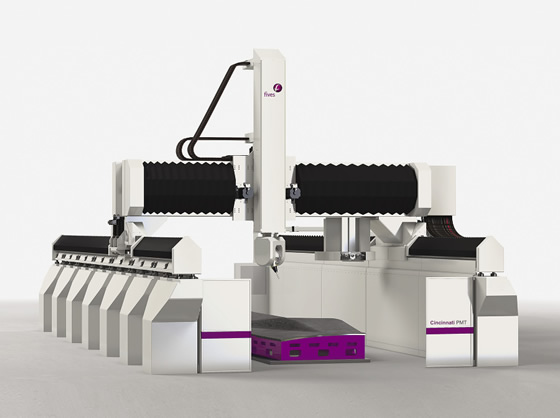
Courtesy of Fives Cincinnati
The Cincinnati Precision Mill and Trim (PMT) machine is built upon a rail-type, vertical-spindle gantry platform and provides 5-axis and five-sided maneuvering for machining large parts made of cured composites and nonferrous alloys.
Bollar added that electrical systems and critical components are fully protected, such as by putting Viton seals on and special pressurized bellows over the way system. In addition, the machine is enclosed to enable integration of a customer’s dust collection system and enhance worker safety. The company developed a dust hood to perform direct dust collection at the tool for 5-axis operations. However, end users sometimes must remove the hood to access space-restricted part features with a tool. “Our customers are leaning toward a full enclosure more than a dust hood because of its greater flexibility in tight spaces where dust hoods are not as practical,” Bollar said.
According to Bollar, it’s not unheard of for a commodity machine with a moving table to last only 6 days when machining abrasive composites, such as silicon carbide. “We’ve had our machines in this environment for almost 4 years and the machines are still working.”
Water World
Dust isn’t an issue when waterjetting composites on the Composite Machining Center, Saberton said. When milling and drilling, however, dust is a major problem, so the machine generates a cold air mist around the cutting tool to cool the tool and form a plume around it.
The dust gets caught in the plume before it has a chance to become airborne and falls down on the part, Saberton noted. The part is then hosed off, the dust goes into a pit underneath the machine and is processed through the filtering system that handles the waterjet waste. “There is no risk to the machine and no risk to people,” he said.
One approach Janicki Industries takes to control composite chips is enclosing the machine in a vacuum system to extract chips after using air at the spindle face to remove them from the cutting tool, Kooda noted. In addition to employing positive air pressure on all electrical boxes and critical components to keep dust out, all bearings are continually greased to prevent carbon fibers from infiltrating them.
Applying coolant is another method for controlling dust. The coolant captures the dust and is filtered with screens designed for the specific type of composite, Kooda said. “On quite a few machines, we use flood coolant to essentially eliminate the dust.”
Unfortunately, not all composite parts can be exposed to flood coolant. Parts with a honeycomb core material or high-density foam, for example, can absorb a metalworking fluid, potentially damaging the material structure and making it prone to delamination. “If any water or fluid gets into that part,” Von Moll said, “it’s a big mess and they can’t use it.”
In addition, any coolant with a rust inhibitor would degrade the quality of carbon fiber and could not be applied during machining, according to Bollar.
Coolant isn’t only potentially damaging to the workpiece. It contains suspended composite dust, which can settle and accumulate as sludge on some areas of a machine. “When that dries it is almost like concrete,” Von Moll said. “You have to go in there with tools and physically bust out the dried sludge.”
Nonetheless, if aerospace OEMs allowed it, “I would do it wet in a heartbeat because of all the dust issues,” Von Moll said, estimating slightly less than half of the composite parts are cut wet and slightly less than half are cut c dry, with coolant misting and possibly cryogenic cooling accounting for the rest.
Often, the only coolant allowed is plain water, usually applied more for controlling dust than cooling, Onsrud’s Cornwell noted. “You don’t want to introduce anything into the cut that can possibly contaminate the part, especially if you have secondary bonding.”
Mixed Media
Part manufacturers tend to segregate machine tools for cutting composites from the ones for machining metal to avoid mixing and possibly contaminating chips—especially when selling themetal chips, Cornwell said. Otherwise, a thorough machine cleaning is required.
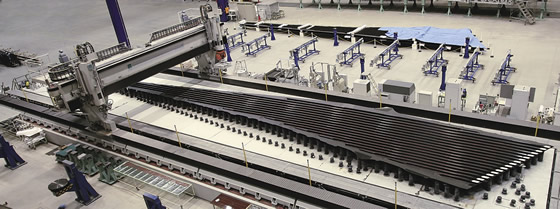
Courtesy of Flow Aerospace
The Composite Machining Center from Flow Aerospace is a gantry-type machine for producing large composite structures, such as this airplane wing skin.
Even machining different composite materials in the same machine can be problematic. That’s because an element, such as Teflon, in one type of composite can interfere with the bonding surface of another. “A lot of the space programs don’t want any Teflon around their parts, so we thoroughly clean the coolant systems between projects,” said Janicki’s Kooda.
Because aerospace composite structures can be quite large, the machining center for cutting them must be highly accurate and reliable, as well as large. For instance, Janicki builds machines with a 100 '×20'×8' (30.5m × 6.1m × 2.4m) milling envelope, Kooda said.
“Some of the programs we work on require a 0.003" hole position over 100',” he said. “If something happens during the machining process, you cannot just go grab another part from the shelf or order another one. The parts are so expensive, it really has to be done right the first time, every time. That philosophy goes into the machine design as well.”
Flow Aerospace’s Saberton concurred: Customers “get a little moody if you scrap one of those parts.” CTE
Simulation critical when cutting composites
Because composite workpieces have a significant amount of process time and labor in them prior to machining, they can be more expensive than even some exotic metal alloy workpieces, according to Bill Hasenjaeger. The product marketing manager for VERICUT machining simulation software developer CGTech, Irvine, Calif., added that it’s not possible to repair a composite workpiece damaged during machining. “Thus, validation of the part program is extremely critical.”
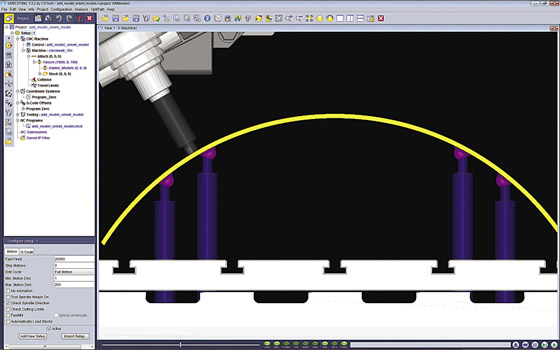
Courtesy of CGTech
When machining thin cross-section composite parts, it’s critical to accurately simulate cutting operations to avoid damaging a “pogo” fixture, which can ruin the fixturing device and cutting tool or cause the workpiece to become loose and suffer damage.
That includes accurately emulating CNC logic and detecting collisions and near misses between the cutting tool and all machine tool components, including axis slides, heads, turrets, rotary tables, spindles, toolchangers, fixtures, workpieces and other user-defined objects.
Composite parts are often found in mission-critical applications, such as aerospace. Typically, an ultrasonic knife or waterjet cuts thin cross sections, such as airframe skins and structural frames and stringers, Hasenjaeger said. He added that simulating these cutting processes requires software that emulates the cutting behavior to detect improper conditions.
In addition, the software must generate accurate material-removal models to compute the cutter contact patch for every cut and avoid melting or burning the heat-sensitive workpiece material. Hasenjaeger noted the appropriate simulation package sets cutting parameter limits and identifies where they are exceeded.
The modifications to machine tools for cutting composites that impact the collision-checking process generally involve vacuum equipment and other hardware used to evacuate dust, Hasenjaeger said. However, the fixtures for cutting thin composite parts can be more complex and costly than ones for other types of machining operations.
Avoiding a tool collision with a workholding device is always important, but avoidance takes on an added dimension when machining these slender workpieces. For example, when using a vacuum fixture, cutting into the fixture beyond a certain depth will break the vacuum, ruin the fixture and set the workpiece free, likely ruining it, Hasenjaeger explained.
He added that another workholding method for these types of parts incorporates “pogos,” individually positioned supports located under a workpiece and with vacuum cups on the ends. “Cutting into a pogo can ruin it and the cutting tool,” Hasenjaeger said, “or cause the workpiece to come loose and ruin it as well.”
—A. Richter
Machining debate: milling versus waterjetting
Compared to milling, waterjetting is a simple operation, according to Mark Saberton of Flow Aerospace LLC. “You turn the waterjet on and whatever is in its way it’s going to cut through. On the other hand, milling is much more complicated as far as the type of tool, the tool geometry, the speeds and feeds. Everything is so much more critical than it is with the waterjet.”
On a typical major composite structure machined with the company’s Composite Machining Center, Saberton noted the waterjet head cuts 95 percent of the features while the other head machines the remainder, such as milling pockets and pads. Because the nonwaterjet operations are more complicated, the machine tool builder spends significantly more time developing composite-machining processes around the milling, drilling and routing operations than the waterjet.
In addition to being simpler, the waterjet produces a smoother cut when processing composites than a rotary tool, Saberton explained. This is because the waterjet’s surface speed is so much higher. He compared a 10mm (0.394") cutter rotating at 15,000 rpm, which has a surface speed of about 28 km/hr. (17.4 mph), to a waterjet traveling at Mach 3, or about 3,600 km/hr. (2,237 mph).
“Just like any type of material, if you bend it real slow and fracture it, you then get a very jagged edge,” Saberton said. “But if you whack it at a high speed, you get a much cleaner cut.”
—A. Richter
Contributors
CGTech
(949) 753-1050
www.cgtech.com
Diversified Machine Systems
(866) 255-2947
www.dmscncrouters.com
Fives Cincinnati
(859) 534-4600
www.fivesgroup.com
Flow Aerospace LLC
(877) 936-4906
www.aipaerospace.com/flowaerohome
Janicki Industries Inc.
(888) 856-5143
www.janicki.com
LMT Onsrud LP
(800) 234-1560
www.onsrud.com
Related Glossary Terms
- abrasive
abrasive
Substance used for grinding, honing, lapping, superfinishing and polishing. Examples include garnet, emery, corundum, silicon carbide, cubic boron nitride and diamond in various grit sizes.
- alloys
alloys
Substances having metallic properties and being composed of two or more chemical elements of which at least one is a metal.
- backlash
backlash
Reaction in dynamic motion systems where potential energy that was created while the object was in motion is released when the object stops. Release of this potential energy or inertia causes the device to quickly snap backward relative to the last direction of motion. Backlash can cause a system’s final resting position to be different from what was intended and from where the control system intended to stop the device.
- burning
burning
Rotary tool that removes hard or soft materials similar to a rotary file. A bur’s teeth, or flutes, have a negative rake.
- centers
centers
Cone-shaped pins that support a workpiece by one or two ends during machining. The centers fit into holes drilled in the workpiece ends. Centers that turn with the workpiece are called “live” centers; those that do not are called “dead” centers.
- composites
composites
Materials composed of different elements, with one element normally embedded in another, held together by a compatible binder.
- computer numerical control ( CNC)
computer numerical control ( CNC)
Microprocessor-based controller dedicated to a machine tool that permits the creation or modification of parts. Programmed numerical control activates the machine’s servos and spindle drives and controls the various machining operations. See DNC, direct numerical control; NC, numerical control.
- coolant
coolant
Fluid that reduces temperature buildup at the tool/workpiece interface during machining. Normally takes the form of a liquid such as soluble or chemical mixtures (semisynthetic, synthetic) but can be pressurized air or other gas. Because of water’s ability to absorb great quantities of heat, it is widely used as a coolant and vehicle for various cutting compounds, with the water-to-compound ratio varying with the machining task. See cutting fluid; semisynthetic cutting fluid; soluble-oil cutting fluid; synthetic cutting fluid.
- fixture
fixture
Device, often made in-house, that holds a specific workpiece. See jig; modular fixturing.
- gang cutting ( milling)
gang cutting ( milling)
Machining with several cutters mounted on a single arbor, generally for simultaneous cutting.
- grinding
grinding
Machining operation in which material is removed from the workpiece by a powered abrasive wheel, stone, belt, paste, sheet, compound, slurry, etc. Takes various forms: surface grinding (creates flat and/or squared surfaces); cylindrical grinding (for external cylindrical and tapered shapes, fillets, undercuts, etc.); centerless grinding; chamfering; thread and form grinding; tool and cutter grinding; offhand grinding; lapping and polishing (grinding with extremely fine grits to create ultrasmooth surfaces); honing; and disc grinding.
- lapping compound( powder)
lapping compound( powder)
Light, abrasive material used for finishing a surface.
- machining center
machining center
CNC machine tool capable of drilling, reaming, tapping, milling and boring. Normally comes with an automatic toolchanger. See automatic toolchanger.
- metalworking
metalworking
Any manufacturing process in which metal is processed or machined such that the workpiece is given a new shape. Broadly defined, the term includes processes such as design and layout, heat-treating, material handling and inspection.
- milling
milling
Machining operation in which metal or other material is removed by applying power to a rotating cutter. In vertical milling, the cutting tool is mounted vertically on the spindle. In horizontal milling, the cutting tool is mounted horizontally, either directly on the spindle or on an arbor. Horizontal milling is further broken down into conventional milling, where the cutter rotates opposite the direction of feed, or “up” into the workpiece; and climb milling, where the cutter rotates in the direction of feed, or “down” into the workpiece. Milling operations include plane or surface milling, endmilling, facemilling, angle milling, form milling and profiling.
- milling machine ( mill)
milling machine ( mill)
Runs endmills and arbor-mounted milling cutters. Features include a head with a spindle that drives the cutters; a column, knee and table that provide motion in the three Cartesian axes; and a base that supports the components and houses the cutting-fluid pump and reservoir. The work is mounted on the table and fed into the rotating cutter or endmill to accomplish the milling steps; vertical milling machines also feed endmills into the work by means of a spindle-mounted quill. Models range from small manual machines to big bed-type and duplex mills. All take one of three basic forms: vertical, horizontal or convertible horizontal/vertical. Vertical machines may be knee-type (the table is mounted on a knee that can be elevated) or bed-type (the table is securely supported and only moves horizontally). In general, horizontal machines are bigger and more powerful, while vertical machines are lighter but more versatile and easier to set up and operate.


